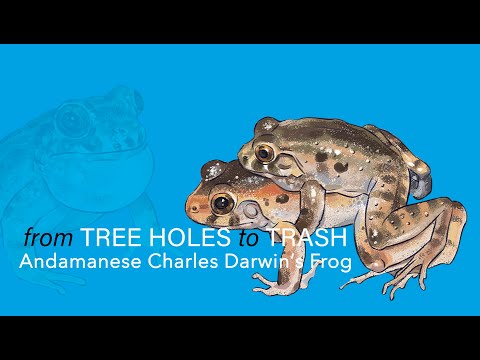Some frog species play dead to avoid mating. Others change color to avoid confusion during mating season. Charles Darwin’s frogs (Minervarya charlesdarwini) do it a little differently. This tiny species named after the British naturalist spawns in an upside-down vertical position and the pair even has to work to get away from jealous males while mating. The findings are described in a study published July 29 in the Harvard Museum of Comparative Zoology’s journal Breviora.
Charles Darwin’s frogs are endemic to India’s Andaman Islands in the Bay of Bengal. The biggest are only 1.5 inches long. They belong to the family Dicroglossidae, which comprises over 220 frog species in Asia.
[Related: A swamp orgy went terribly wrong for these prehistoric frogs.]
In the new study, a team from the University of Delhi, Zoological Survey of India, Harvard University, and the University of Minnesota spent over 55 nights during the monsoon season to observe the secretive reproductive behavior of these frogs.
Charles Darwin’s frogs naturally breed and deposit terrestrial eggs above the water surface using the inner walls of water-filled tree cavities or root buttresses. The hatchlings then drop into the water and complete their development up to a free-swimming tadpole stage.

For comparison, most of over 6,000 known frog species mate and spawn in water or other land-based habitats. The female then lays eggs during mating, while the male releases sperm. Instead of this method, a mating pair of Charles Darwin’s frogs will use a vertical, upside-down posture on a tree cavity wall with their bodies totally out of the water.
“Upside-down spawning is the most remarkable behavior in this frog. No other frog is known to lay terrestrial eggs inside tree holes in an upside-down position,” study co-author and University of Delhi biologist S. D. Biju said in a statement. “This discovery is fundamental for understanding how the species interacts with its environments and which habitats are essential for its survival. Such specialized traits also yield insights into the evolution of reproductive modes and behaviors among anuran amphibians.”
The unique mating style also has a vocal element. The male frogs produce complex advertisement calls made up of three different call types used to attract females. They also make a more aggressive call to ward off their competition. When these more fierce vocalizations don’t ward off competing males, the fighting begins. They kick and box using their hands and legs and can bite off a rival’s body parts–even an entire head.
When and if a male successfully mounts a female, the nearby unpaired males may also physically fight with already paired-up frogs. They may even try to insert their heads in between the bodies of the pair behind that is mating to try and separate them. The defending male will often kick the intruding males with his hind legs.
Not to be outdone, the females will climb up the wall of the tree hole with the male on her back to avoid attacks from intruding males.
The team believes that the upside-down spawning behavior in Charles Darwin’s frogs may have evolved a way to prevent the aggressive unpaired males from displacing the already coupled pair from behind and disrupting egg-laying.
“This finding is an example of the remarkable diversity of amphibians and reproductive behaviors that are still unknown to science, especially from unexplored regions in biodiversity hotspots of tropical Asia,” study co-author and Harvard University comparative zoologist James Hanken said in a statement.
[Related: These Australian frogs get absolutely covered in seeds.]
The team frequently observed frogs breeding in unnatural sites in disturbed forests. They bred in areas ranging from artificially watered plastic sapling bags in plant nurseries nearby to rain-filled, discarded plastic, glass or metal containers that were left as trash on the edge of the forest.
Due to habitat loss, Charles Darwin’s frogs are facing a lack of adequate breeding sites and added competition. This may be driving them to breed in these more unnatural human-made sites. Despite taking advantage of trash, the species might not survive increasing human dominance and the drastically changing landscapes on the small islands they call home. They are currently listed as vulnerable on the IUCN Red List and the study calls for increased attention to this endemic species.
“The frogs’ use of trash for breeding is both surprising and worrying,” Sonali Garg, study co-author and Harvard University Biodiversity Postdoctoral Fellow, said in a statement. “We now need to know its causes and long-term consequences, and devise ways to protect the natural breeding sites that are critical for survival of the species.”

